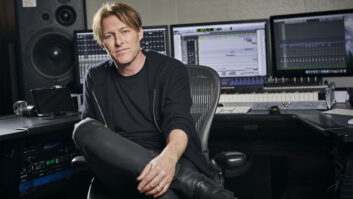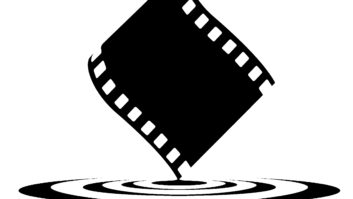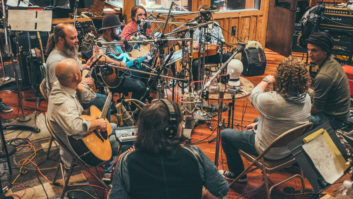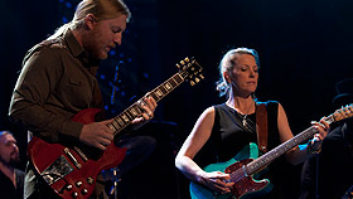
Four-time Grammy-winning producer John Snyder gets to have a lot offun. When he’s not busy producing living legends like Dave Brubeck,George Shearing and Joe Williams, he’s making records with youngercomers such as saxophonist David Sanchez, pianist Danilo Perez andtrumpeter Tom Harrell. For a change of pace he fishes and bicycles andmakes records at a Bayou-side studio-cum-leisure complex in Louisianawith people such as James Cotton and Clarence Gatemouth Brown.
Between producing gigs, Snyder supervises compilations and reissues,everything from the Jefferson Airplane (After Bathing at Baxter’s andBless Its Pointed Little Head, among others) to Miles Davis (Miles inthe Sky, Miles Smiles) and Glenn Miller (Moonlight Serenade, CarnegieHall Concert).
Snyder apparently does it for the love of the music, as evidenced byhis claim that he’d give it all up in a second if he could play leadtrumpet in the hard-working, globe-trotting legacy edition of hisall-time favorite band, the Count Basie Orchestra. That position,however, is filled, so Snyder continues on recording the music heloves.
Snyder’s recently completed projects include two 1998 Christmasrecords-one each with George Shearing and Etta James-and a Jim Hall/PatMetheny collaboration. He’s also just completed I Remember Bill, stararranger Don Sebesky’s piano-less tribute to piano great Bill Evans,which features Tom Harrell, nascent sax legend Joe Lovano and guitaristJohn Pizzarelli. Snyder also completed Quintet, the second record by19-year-old slide guitar phenom Derek Trucks. Upcoming projects includea tribute to Bob Dylan by various blues artists and a possiblefollow-up to Snyder’s popular Paint It Blue: Songs of the RollingStones, which will feature Stones songs covered by the likes of LutherAllison, Johnny Copeland, the Holmes Brothers and Gatemouth Brown,among others.
How did you become a record producer?
I was born in Charlotte, N.C., in 1948. In Charlotte in those days,there was one record store; really a hi-fi store with a few records. SoI joined the Capitol Record Club-the first record I got was MilesDavis’ Birth of the Cool, which scared me to death! I’d never heard aBeatles record until way after the fact, but I knew every Miles record.And so I took up the trumpet.
I was pretty serious about music in high school, playing trumpeteverywhere I could, and got a music scholarship to the University ofNorth Carolina, where I got a degree in music ed. Then I went to lawschool at UNC-Chapel Hill. I went to law school because I’d done wellin a criminology class and was urged to study law by that professor,and because the dean of the UNC law school was a big music fan andreally wanted me there!
Also, it was the late ’60s and law schools were looking fordiversification-women, blacks, weirdos-and I fit the weirdo category. Ididn’t love it, but I went through the whole three years of law school.I thought law school would be more serious than it was, but it was justa memory thing; you jump through the hoops and you pass. So I jumpedand did pretty well.
After law school I was interviewing for jobs at banks and insurancecompanies and I knew this was not for me. So I wrote to all theentertainment law firms in New York City and to one record producer,Creed Taylor, founder of CTI Records, who wrote me back and said, “Ifyou’re in New York come and see me.” I drove up and met with a few lawfirms and with Creed, and he hired me on the spot.
This was 1973; my job was to run CTI’s publishing companies, listento the tapes that came in, look over the contracts. It didn’t hurt thatI knew every record Creed had ever made! One day Creed said, “HankCrawford’s coming in tomorrow and we need some songs.” I picked outsome songs for Hank, and they took every one. After that, Creed askedme to continue to look for songs. So I started spending evenings in theoffice listening to a lot of records. Then CTI started to go downhillbecause of the branch distribution setup they had but could notsupport. I took over the jobs of many people who were fired, andeventually touched on almost every job at CTI-manufacturing, A&R,distribution, creative services, everything. It was an education in therecord business I doubt you could get these days. Then, finally, CTIjust went out of business.
So I went to A&M in 1975 and started a new label called Horizon,and we recorded artists like Ornette Coleman [Dancing in Your Head] andDave Brubeck [Dave Brubeck Quartet 25th Anniversary Reunion and DaveBrubeck & Paul Desmond Duets] and that lasted a couple of years. Itried to sign George Benson to A&M just after he left CTI andbefore he went to Warner Bros. and sold 10 million records, but A&Mwouldn’t give me the money, so I didn’t get George. You can’t win ’emall.
After A&M, in 1977, I started my own record company calledArtists House with Ornette [Body Meta, The Quartet], Paul Desmond [PaulDesmond], Art Pepper [So in Love, Lover Man], Chet Baker [Once Upon aSummertime, The Quintet], Gil Evans [Solo] and others. That lasted fiveyears; I kind of got run out of town by MCA with a bad distributiondeal. So then I was sort of on my ass for a couple of years.
While I was out of work, I was Mr. Mom back in North Carolina.Fortunately, John Hammond was a mentor to me and was always trying toget me work at CBS. Finally, I called John one day and said, “I’vereally got to get back.” He said, “Well, you know I’m the old fart atCBS now and they don’t pay me any attention.” I asked him to introduceme to Ahmet Ertegun, founder of Atlantic Records, which he did,insisting that Ahmet’s office put him through even though Ahmet was inhis dentist’s chair at the time! John talked me up as Ahmet was gettingdental work done.
Ahmet hired me and I ran a jazz division that I created. And therewere some blues records they asked me to take care of, so I ended upwith a staff of five or six people. Ahmet wasn’t comfortable with that,even though his chief of staff had made it happen. He tried to fire meone day, but I talked him out of it.
By now it was 1987, so I wrote Ahmet a report on how to make moneyputting his jazz records on CD, which he didn’t think was possible. Igave it to him on a Monday, and he fired me later that day! He was alsogenerous with the severance pay, but I was really glad to get out ofthere; it was like a totalitarian state.
So from then on, I’ve been independent. I do a lot of reissue workfor RCA and GRP, and I worked at Sony for a number of years also doingreissues. But that’s just sort of rent money, because basically whatI’ve done since then is make jazz records-everything from Tom Harrell,Danilo Perez, Paul Desmond, Dave Brubeck, Chet Baker and Gerry Mulliganto Ornette, Cecil Taylor and Sun Ra. I’ve been lucky. I also startedmaking blues records about five years ago and have had pretty goodsuccess with that. I had a contract with PolyGram for five years andwith Telarc for six years, to produce jazz and blues records. I have awide range; I do Bobby Short’s records and James Cotton’s. I do somegospel, some classic R&B.
What are you excited about right now?
I’ve just done my second record with Derek Trucks, a young slideplayer who I think has an incredible future; he’s certainly had anincredible past. He’s 19 and has been on the road with his own bandsince he was 11. His uncle is Butch Trucks, the drummer in the AllmanBrothers. Since Derek’s been on the road almost half his life, he’sreceived his education through the mail and by phone.
He’s extremely smart; he’s like a sponge. He said to me recently,”Hip me to Plato.” I said, “Hip you to Plato? Go practice yourinstrument!” But I gave him Bertrand Russell’s History of WesternPhilosophy and he just soaked it up. He’s into all kinds of music;world music, Indian music.
Derek likes to play Coltrane and Miles and he loves Sun Ra. He wentthrough his blues phase from 12 to 13, then he had to move on; itwasn’t interesting enough for him! I think of him as a Weather Reportor Mahavishnu type of artist, as an alternative to theneo-traditionalism that is so in fashion now in jazz, through theWynton Marsalis influence. That’s what interests me about him.
Let’s talk about how you work. Do you do a lot of rehearsals beforeyou start a record?
That depends on the situation. When I recorded Sun Ra, I wasdetermined to make really good-sounding Sun Ra records. Sonny’s recordshad always been made under the oddest of circumstances. And after Imade my first Sun Ra record [Blue Delight] and it sounded pretty good,I was determined to make an organized Sun Ra record, which is probablyan oxymoron. So we had two or three days of rehearsal for this newrecord [Purple Night]. We get to the date, at RCA, with Don Cherry and20 musicians, and Sonny and his musicians started playing this music wehadn’t rehearsed; it was just sort of going along. And Sonny wouldn’ttalk, he would just play. Suddenly there was this sound, it was like abig spaceship just took off, exactly that image-I could see it, it wasjust great. But it wasn’t anything that we’d rehearsed!
After the date I asked Sonny, “Why didn’t you do any of the songsthat we’d rehearsed?” He said, “Think of it this way: I’m a footballcoach. We practice all week long but we don’t play the same game onSunday that we did all week.”
So despite that experience, I’m always surprised that rehearsalsdon’t play a bigger part in pre-production, but when you are hiringmusicians from various parts of the country, it is hard to get themtogether a week or a month ahead of time.
So how do you approach a recording?
It depends on the musical genre. I find that blues artists are moremalleable and workable; they’re not uptight about it. Jazz artists aremuch more proprietary about what they do, and the influence you have ismuch more subtle; I don’t direct jazz dates as much as I do with ablues record.
I listen carefully. I’ve been in bands, I know what they do, whatthey’re going through, and I always try to pick out something great,something really positive about what somebody’s playing. And then theyknow I’m listening, and it makes it easier for me to tell them whenthey’re not doing something well.
You work in a lot of different studios…
There’s a studio in Maurice, Louisiana, where I’ve made more than 20records, called Dockside. At Dockside, the studio environment becomesan active participant in recording. It’s on a 12-acre estate; there’s alake stocked with fish- you can’t fail to catch a fish there-and thereare tennis and basketball courts and miles of flat country roads forbicycling. And they’ve got two vintage Neve boards and two Studeranalog machines. You bring musicians there and they sleep, eat, workand play there. It creates a real mutuality, a kind of community ofinterest, and everyone’s very relaxed. There are no problems, thefood’s good, and I always get great records out of there.
Let’s go over the nuts and bolts of how you record.
We record the bass direct; we have an amp but don’t use it much. Theguitars are isolated but not direct, so you need great amps. It’s likea meal: The better the ingredients, the better the result. I’ve alsohad access to some great instruments through Dockside, like a 1956Gibson Les Paul and other wonderful stuff. You put an instrument likethat in a guitar player’s hand and he plays better. He knows he’s got aworld-class instrument there.
We use Neumann mics a lot: 67s, 47s; the mic selection at Docksideis pretty good. They also have Telefunken U47s, Neumann M49s, AKG C24sand, of course, workhorse mics like Sennheiser 421s, Shure 57s and AKG414s.
Telarc, where I’ve made many records, has its own equipment forrecording direct-to-2-track, and it is also good. Their thing is2-track and picking the right room. It’s fine to make a classicalrecording direct-to-2 in a great hall, but it’s not great for the bluesrecords and is not always the best way to cut jazz. But the sound isalways superb. They usually run a DAT for the direct-to-2-track andback it up with 48-track recording, for remixing to surround sound.Telarc favors Neumann M50s and M49s, among other mics.
But Telarc doesn’t just do direct-to-2-track. The late Junior Wells’last record was for Telarc, Live at Buddy Guy’s Legends. We cut on 24tracks of ADAT at Buddy Guy’s Chicago club and then mixed to 5.1. Ibelieve this record was the first live 5.1 blues recording. I think 5.1is the future. If you listen to the Junior Wells record in 5.1, youthink you are in Buddy’s club. There is nothing two-dimensional aboutthat recording.
Tell me what it is like making these blues records.
We try to keep it fun. We have a lot of laughs down there atDockside. We often cut the tracks in three days, sometimes less, notoften more, because the budgets aren’t that big. Then we spend a coupleof days overdubbing and three or four days mixing. They’re seven- toten-day records; I’ve certainly made them in less time. If they giveyou $25,000 to make a record, you’ve got two or three days at the mostto track and then two or three days to mix. I don’t really like to makethose kinds of records because the budgets create such constraints, butyou do what you have to do.
I usually have a tape of some preliminary version of what I want foreach song. I try to rehearse the first day and run through the songs.But when you’re using studio cats, they’ll usually just say, “Look,we’ll rehearse the song and then record the song and then go to thenext one,” which is fine.
I just love the chaos. For me, the fun is going into the studio,where no one has the faintest idea of what we’re going to do, and thenyou bring order to the chaos. It’s like cleaning up a dirty house. Thehouse is a wreck, and you just put it back together. I know the musicis in there someplace; you just have to go and find it.
What’s your goal in recording these legendary blues artists likeGatemouth Brown, James Cotton and the late Junior Wells?
My thrust with blues guys is to make a great record and hopefullywin a Grammy and sell a lot of records so that their live performancemoney goes up.
That happened with Gate, with Junior and with Cotton: Their livefees increased dramatically, and I’m really happy about that. The mainway these guys make money is from working live, and I want to see thatthey get the best money possible for all these shows. With GatemouthBrown, we got Eric Clapton to play on the record. Actually, Gate didn’tknow who Eric Clapton was! We got Eric to play on Gate’s record alongwith Ry Cooder and other people, and all of a sudden Gate sells 100,000records and his performance money triples, and to me that’s the wholepoint.
You’ve also made several records in the last few years with thegreat singer Joe Williams, who is still going amazingly strong as henears his 80th birthday.
There’s a true gentleman there. He’s also a guy who always has a lotof fun. I grew up listening to Joe Williams singing with Count Basie.Count Basie was my band! I wasn’t one of those Duke Ellington guys- ittook me a few years to appreciate Ellington-but Basie I got right away.As a kid who played trumpet, my goal was always to be lead trumpetplayer in the Count Basie band, and it still is. If I could play leadtrumpet in the Basie band today, I’d do it!
The Count Basie Orchestra, the legacy band, is still a truly greatband.
I’m telling you! We did the Live in Detroit record a few years ago,reuniting Joe Williams with the Count Basie Orchestra for the firsttime on record in a very long time. That was a thrill. Since thatrecording, for which the Basie band got together a real book to usewith Joe, the band and Joe have been doing a lot of live dates.
Talking about Joe Williams reminds me of how close we are to thebeginnings of jazz. A hundred years from now it will be like classicalmusic-everyone will be dead and gone. We know people who knew peoplewho were there at the beginning. But not for long. Joe has a famousquote about how one day soon there won’t be anyone left who ever heardBillie Holiday sing live.
So I think we’re living in a golden time, at least for the music.Maybe it was more of a golden time 20 years ago or so. But still, todayis a golden time. Guys like Joe Williams, Max Roach, Dave Brubeck,George Shearing-the older guys who’ve seen it and been there-they wereall friends with Louis Armstrong and Charlie Parker and Miles Davis.And so the chain of jazz is just a short chain. We’ve seen the linksbeing formed in those people’s lives. It’s an amazing thing.
Sometimes if I’m in a record date and I’m having problems with themusicians focusing or getting in the right frame of mind, I’ll tellthem what I think, which is that music is a powerful medium that canchange people’s lives, that can make people feel good and bringsomething positive into the world that wasn’t there before. That’s anamazing thing, and the world needs more of that.
And if we have the opportunity of doing that-creating somethingthat’s going to last who knows how long, and will affect people’s livesin a positive way over and over again-we’ve done a good thing. I don’tknow what could be better than that; I really don’t. That’s why Iconsider myself a lucky person to be able to work with people who cando that; it’s a wonderful thing.






